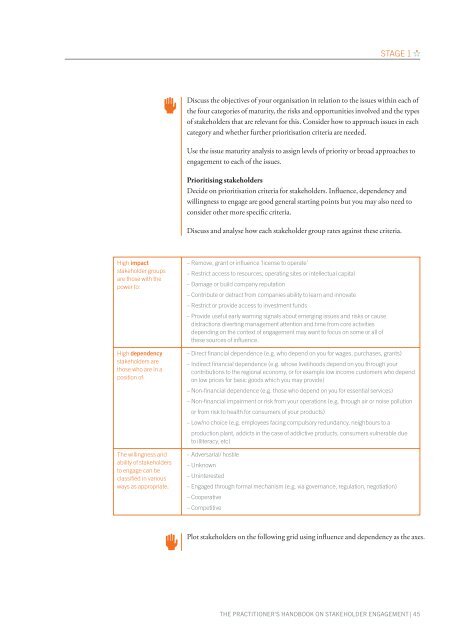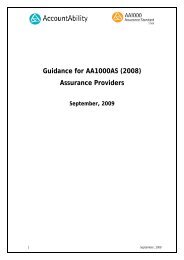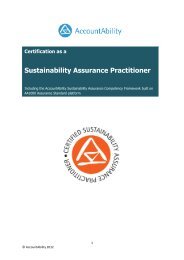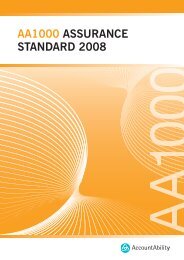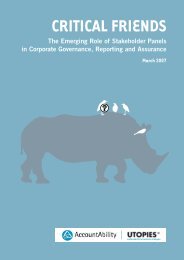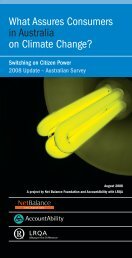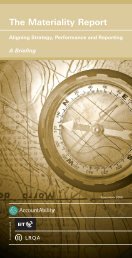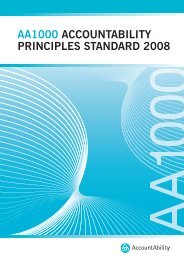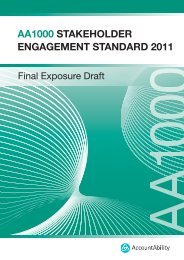The Stakeholder Engagement Manual Volume 2 - AccountAbility
The Stakeholder Engagement Manual Volume 2 - AccountAbility
The Stakeholder Engagement Manual Volume 2 - AccountAbility
Create successful ePaper yourself
Turn your PDF publications into a flip-book with our unique Google optimized e-Paper software.
High impact<br />
stakeholder groups<br />
are those with the<br />
power to:<br />
High dependency<br />
stakeholders are<br />
those who are in a<br />
position of:<br />
<strong>The</strong> willingness and<br />
ability of stakeholders<br />
to engage can be<br />
classifi ed in various<br />
ways as appropriate:<br />
STAGE 1<br />
Discuss the objectives of your organisation in relation to the issues within each of<br />
the four categories of maturity, the risks and opportunities involved and the types<br />
of stakeholders that are relevant for this. Consider how to approach issues in each<br />
category and whether further prioritisation criteria are needed.<br />
Use the issue maturity analysis to assign levels of priority or broad approaches to<br />
engagement to each of the issues.<br />
Prioritising stakeholders<br />
Decide on prioritisation criteria for stakeholders. Infl uence, dependency and<br />
willingness to engage are good general starting points but you may also need to<br />
consider other more specifi c criteria.<br />
Discuss and analyse how each stakeholder group rates against these criteria.<br />
– Remove, grant or infl uence ‘license to operate’<br />
– Restrict access to resources, operating sites or intellectual capital<br />
– Damage or build company reputation<br />
– Contribute or detract from companies ability to learn and innovate<br />
– Restrict or provide access to investment funds<br />
– Provide useful early warning signals about emerging issues and risks or cause<br />
distractions diverting management attention and time from core activities<br />
depending on the context of engagement may want to focus on some or all of<br />
these sources of infl uence.<br />
– Direct fi nancial dependence (e.g. who depend on you for wages, purchases, grants)<br />
– Indirect fi nancial dependence (e.g. whose livelihoods depend on you through your<br />
contributions to the regional economy, or for example low income customers who depend<br />
on low prices for basic goods which you may provide)<br />
– Non-fi nancial dependence (e.g. those who depend on you for essential services)<br />
– Non-fi nancial impairment or risk from your operations (e.g. through air or noise pollution<br />
or from risk to health for consumers of your products)<br />
– Low/no choice (e.g. employees facing compulsory redundancy, neighbours to a<br />
production plant, addicts in the case of addictive products, consumers vulnerable due<br />
to illiteracy, etc)<br />
– Adversarial/ hostile<br />
– Unknown<br />
– Uninterested<br />
– Engaged through formal mechanism (e.g. via governance, regulation, negotiation)<br />
– Cooperative<br />
– Competitive<br />
Plot stakeholders on the following grid using infl uence and dependency as the axes.<br />
THE PRACTITIONER'S HANDBOOK ON STAKEHOLDER ENGAGEMENT | 45


